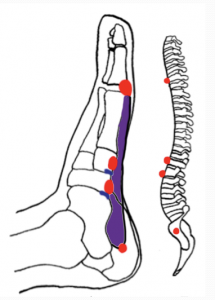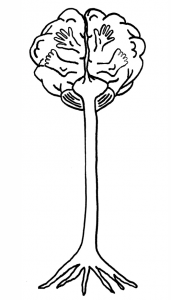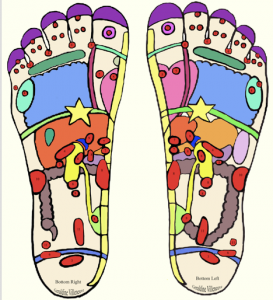 Since the early years of my reflexology practice I’ve been particularly fascinated with how accurate the curves of the medial arch of the foot match the actual spinal curvatures of that individual. Many of my clients have verbally expressed feeling tension in the muscles along their spine melt away when the arch of their foot is reflexed during their reflexology session, reassuring its microcosmic connection. You may be familiar with a similar reflexive sensation when putting cold feet into a warm foot bath.
Since the early years of my reflexology practice I’ve been particularly fascinated with how accurate the curves of the medial arch of the foot match the actual spinal curvatures of that individual. Many of my clients have verbally expressed feeling tension in the muscles along their spine melt away when the arch of their foot is reflexed during their reflexology session, reassuring its microcosmic connection. You may be familiar with a similar reflexive sensation when putting cold feet into a warm foot bath.
Thousands of nerve endings in our feet connect sensory neural pathways to the brain and once the message is received motor neurons respond and react to the sensation. For example when one steps on a tack the sensation (sensory neuron) is communicated to the brain and the brain responds by sending a signal of pain via the motor neuron to make sure you lift your foot off the tack. It’s call a reflex arc. This is why reflexology works so well to relieve stress because we are continually communicating relaxation sensations to the brain through the feet.
At an International Council of Reflexology (ICR) conference in Vancouver, BC, guest speaker Dr. Mary Tuchscherer, DC spoke about her research on Peripheral and Central Reflex Activity. She explained that the feet and hands take up more space in the brain than any other organ in the body.

Caricature illustration of the brain and spinal cord by Geraldine Villeneuve
She asserted the feet and hands have a direct communication pathway to the brain to preserve and protect the central nervous system. We sense our environment through our hands and feet, not as much as with our elbow, and this is why we can provide a calming stimulus through these areas of the body.
Foot reflexologists understand feet as a microcosm, or mini-map of the entire body, and this profession is famous for its ability to provide stress relief.
Structural reflexologists go a step further and also focus on relieving stress in the local, muscle, and ligament structure of the feet.
Techniques are applied to specific areas on each foot to release joint tension and enhance foot function. These areas of tension are usually muscle attachment sites that overlap with reflexes. Structural reflexologists learn to read the constitution of the body through the feet as a microcosm as well as understand when there is a mechanical issue causing weight distribution problems. Aberrant muscles that struggle to move the feet send signals to the brain that something is not right and the brain attempts to make the neural correction by communicating pain to muscle sites. This is a reflex arc in action– and reflexologists feel these raised areas or inflammation beneath thumbs and fingers when reflexing feet.
 Sites of muscle attachments and reflexes on the feet© Geraldine Villeneuve
Sites of muscle attachments and reflexes on the feet© Geraldine Villeneuve
Let’s address my image above of the arch of the foot in relationship to the spine of the body.
The main muscle along the medial arch of the foot is called the abductor hallucis muscle (purple area in the image above). It’s job is to keep the great toe straight and assists the arch in shock absorption during foot locomotion. It inserts on the medial side of the proximal great toe (MPJ) and originates on the inside of the heel bone (calcaneus).
When a callus exists at the MPJ at the great toe, a structural reflexologist will assess this issue as excessive friction and understands why the body reacted to protect the joint from further injury by accelerating tissue growth at the site. The callused site is also recognized as an affected reflex area correlating to the lower cervical and upper-thoracic vertebrae and the thyroid gland. The origin of the abductor hallucis on the inside of the heel bone shares a connection with the uterus/prostate reflexes. A strained abductor hallucis will be palpable as this reflex site will feel raised in texture beneath the skin.
In my decades of reflexology and massage practice I feel confident in saying foot reflexes and foot muscles are inter-related. In order to make a lasting and an wholistic impact on improved health and vitality their symbiotic relationship must to be addressed, as one clearly belongs to the other.
The next time you massage or reflex the arch of someones foot, expand your awareness to include the local and reflexive connections and understand the brain is listening and ready to respond.
Better yet, learn more by joining one of my Structural Reflexology® classes. You will be so glad you did.
All illustrations in this post were designed by Geraldine Villeneuve
Archives
- October 2024
- December 2023
- October 2023
- March 2022
- July 2021
- August 2020
- May 2020
- April 2020
- February 2020
- January 2020
- December 2019
- November 2019
- October 2019
- August 2019
- June 2019
- May 2019
- April 2019
- January 2019
- December 2018
- October 2018
- September 2018
- July 2018
- June 2018
- April 2018
- February 2018
- December 2017
- November 2017
- October 2017
- September 2017
- August 2017
- July 2017
- June 2017
- May 2017
- April 2017
- February 2017


